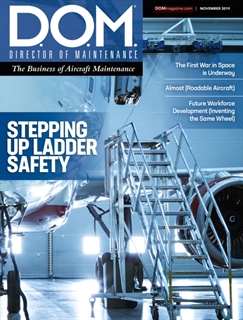 In the November 2019 edition of D.O.M. Magazine (the premier magazine for aviation maintenance management professionals), an article that was authored by Wildeck was featured on the front cover. The article, entitled “Stepping Up Ladder Safety: Rules and Best Practices for Rolling Ladders and Work Platforms,” offered an in-depth look at the implications of the 2017 changes to OSHA’s Walking-Working Surfaces and Personal Fall Protection Systems rule (29 CFR part 1910, subpart D) for aviation access products.
In the November 2019 edition of D.O.M. Magazine (the premier magazine for aviation maintenance management professionals), an article that was authored by Wildeck was featured on the front cover. The article, entitled “Stepping Up Ladder Safety: Rules and Best Practices for Rolling Ladders and Work Platforms,” offered an in-depth look at the implications of the 2017 changes to OSHA’s Walking-Working Surfaces and Personal Fall Protection Systems rule (29 CFR part 1910, subpart D) for aviation access products.
In an attempt to establish great continuity across multiple industries, OSHA took the publication of this new rule as an opportunity to more clearly define and regulate commonly used pieces of equipment. Consequently, some of the most significant changes to emerge from these efforts were the alterations made to the standards for mobile ladder stands and mobile ladder stand platforms, two pieces of equipment frequently used with aviation maintenance professionals.
Mobile ladder stands (aka rolling ladders or ladder stands) and mobile ladder stand platforms (aka work platforms) are frequently used to get aircraft technicians within arm’s reach of the task at hand. The following list outlines some of the new specifications that these elevated pieces of equipment must meet to be considered OSHA compliant.
- The steps of the mobile ladder stand or platform must have a step width of at least 16 inches (41 centimeters); a rise of not more than 10 inches (25 centimeters); and a depth of not less than 7 inches (18 centimeters). Additionally, steps must be uniformly spaced and arranged.
- The steps and working surfaces on the mobile ladder stand or platform must be slip-resistant. Slip-resistant surfaces must be either an integral part of the design and construction of the mobile ladder stand or platform or added as a secondary process or operation (i.e. dimpling, knurling, shot blasting, coating, spraying or applying durable slip-resistant tapes).
- Mobile ladder stands and platforms must be capable of supporting at least four times their maximum intended load. Additionally, the wheels or casters on the stand or platform must be capable of supporting their proportional share of four times the maximum intended load (in addition to their proportional share of the unit’s weight).
- Handrails must be installed on every open side of the mobile ladder stand or platform, excluding entrances. Exceptions to this rule can be made when the ladder or platform is up against another vertical surface.
Wildeck offers a comprehensive line of customizable aerospace and specialty access products, including mobile ladder stands and mobile ladder stand platforms. In addition to ensuring that all our products comply with OSHA’s regulations, our team of highly capable engineers can design solutions that are tailored-made to your facility and operations. If you are interested in learning more about Wildeck’s unique approach to access products, please contact us at info@wildeck.com or (800) 325-6939. We are here to help take your aviation facility to new heights.